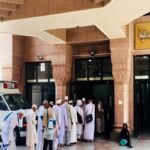UNITED NATIONS, Dec 29 (APP): Israel’s expanding ground offensive across the Gaza Strip is sending new waves of displaced people – at least 100,000 so far – into Rafa, the enclave’s overcrowded southern city, where locals are already underfed and desperate under continuing bombardment, UN humanitarian officials said Friday.
“A traumatized and exhausted population” is being “crammed into a smaller and smaller sliver of land,” UN emergency relief chief Martin Griffiths warned on social platform X on Friday.
Efforts to deliver medical supplies and fuel to the hospitals still functioning in and around Rafah have been increasingly disrupted by hungry people stopping convoys in search of food, the World Health Organization said this week.
Twelve weeks into Israel’s campaign against Palestinians, more than 21,000 people in Gaza have been killed and there is little relief in sight.
According to media reports, talks in Cairo, and an Egyptian ceasefire proposal, appear to be in early stages, and Hamas says it will not return Israeli hostages until the fighting stops.
Israeli Prime Minister Benjamin Netanyahu, visiting Gaza this week, said the war “isn’t close to finished”.
UN calls for urgent aid scale-up amid new mass exodus to Rafah
UN humanitarian affairs coordination office OCHA cited reports from Gaza’s health authorities that half of all the pregnant women seeking safety in shelters in the Strip suffer from thirst, malnutrition and a lack of health care, there is a lack of vaccinations for newborns and one in every two displaced children faces dehydration, malnutrition and disease.
Some 1.9 million Gazans, or 85 per cent of the enclave’s population, have been internally displaced since the start of Israel’s retaliation following Hamas’ attacks in southern Israel on October 7.
According to OCHA, the latest wave of displacement was prompted by an intensification of hostilities in the southern town of Khan Younis and central Gaza’s Deir al Balah, as well as evacuation orders issued by the Israeli military.
Some 10 days ago Rafah was already estimated to be the most densely populated area in Gaza, exceeding 12,000 people per square kilometre, OCHA said, which is more than in New York City.
Despite a UN Security Council resolution adopted last week calling for a scale-up in aid deliveries to the enclave, access to people in need has remained overwhelmingly insufficient.
Only 76 trucks entered Gaza from Egypt through the Rafah crossing on Thursday, “well below the daily average of 500 truckloads (including fuel and private sector goods) that entered every working day prior to October 7”, OCHA noted.
“You think getting aid into Gaza is easy? Think again,” the UN’s Mr Griffiths wrote on X on Friday. He listed the impediments faced by humanitarians working to help people in the Strip, including “three layers of inspections before trucks can even enter”, insufficient entry points, “constant bombardment” and damaged roads.
“This is an impossible situation for the people of Gaza and for those trying to help them. The fighting must stop,” he insisted.
Last week UN chief Antonio Guterres said,“An effective aid operation in Gaza requires security; staff who can work in safety; logistical capacity; and the resumption of commercial activity.”
“These four elements do not exist,” he concluded.
Despite the challenges, humanitarians have continued doing their utmost to assist desperate Gazans. On Thursday the UN World Food Programme (WFP) distributed food parcels for 10,000 displaced families in makeshift camps in Rafah.
OCHA reported that some 200 community leaders were identified to collect assistance on behalf of surrounding families in their communities, with each parcel covering a family’s food needs for 10 days.
“Incredible to see the collab[oration] between the team and communities as we race against time to deliver life-saving food in Gaza,” WFP representative in Palestine Samer AbdelJaber wrote on the social platform X.
The distribution was set to continue on Friday after time and safety constraints meant that only 45 per cent of people targeted with assistance were reached on the first day.
Last week, humanitarian officials warned that more than one in four households in Gaza were enduring “catastrophic” hunger.
The risk of famine occurring in the Strip within the next six months was confirmed by the latest Integrated Food Security Phase Classification (IPC) report, which showed that the entire population of Gaza, some 2.2 million people, is living with “crisis or worse” levels of acute food insecurity.






